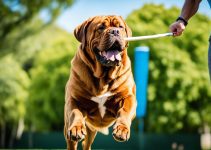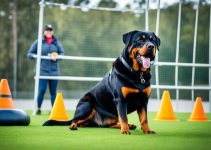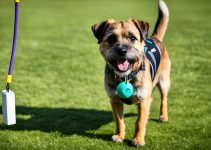Giant Schnauzers are incredible dogs with unique training needs. As a dog trainer with years of experience, I have discovered effective techniques to enhance obedience and behavior specifically tailored for this magnificent breed. In this article, I will share my top tips for successful Giant Schnauzer training using positive reinforcement methods.
Giant Schnauzer Training
- Positive reinforcement is crucial for training Giant Schnauzers.
- Understanding the breed’s characteristics and history is important for effective training.
- Basic obedience training, housebreaking, and crate training are essential.
- Advanced training techniques can enhance your Giant Schnauzer’s skills.
- Behavior training helps address any behavioral issues.
Understanding the Giant Schnauzer Breed
The Giant Schnauzer is a powerful and muscular breed that closely resembles the Standard Schnauzer but on a larger scale. They were developed in the mid-1800s in the Bavarian Alps for driving cattle and were later utilized as guard dogs and working dogs for the police and military.
Giant Schnauzers have a height range of 25.5-27.5 inches (male) and 23.5-25.5 inches (female), and a weight range of 60-85 pounds (male) and 55-75 pounds (female). They possess a distinctive coat that is dense and wiry, requiring regular grooming to maintain its texture and appearance. With their keen intelligence and strong loyalty, Giant Schnauzers are highly trainable and can excel in various activities such as obedience, agility, and tracking.
Understanding the breed’s history and characteristics is essential for effective training. Giants are known for their confidence and protective nature, making them excellent family companions and watchdogs. They are energetic dogs that require regular exercise to maintain their mental and physical well-being. The breed’s temperament can vary, but they generally exhibit a strong-willed and dominant personality, requiring an experienced and firm yet positive owner.
Training Basics for Giant Schnauzers
Like all dogs, Giant Schnauzers require basic obedience training to ensure good behavior and proper communication with their owners. It is essential to establish a strong foundation of obedience commands, such as sit, stay, and come, to ensure that your Giant Schnauzer understands and follows your instructions.
To facilitate effective Giant Schnauzer training, consistency and positive reinforcement are key. Use rewards such as treats, praise, and playtime to motivate and reinforce desired behaviors. This will help your Giant Schnauzer associate obedience with positive experiences and encourage them to repeat those behaviors in the future.
In addition to obedience training, housebreaking is an important aspect of training for Giant Schnauzers. Establishing a routine for bathroom breaks and consistently reinforcing appropriate elimination behavior can help prevent accidents in the house. Be patient and consistent during this process, and remember to reward your Giant Schnauzer for successfully going outside.
Crate training is another valuable tool for Giant Schnauzer owners. Introducing your dog to a crate can provide them with a safe and secure space, as well as aid in housebreaking. Gradually introduce your Giant Schnauzer to the crate, using positive reinforcement to make it a comfortable and inviting space. Use the crate for short periods initially, gradually increasing the duration, and never use it as a form of punishment.
By implementing basic obedience training, housebreaking, and crate training, you can establish a strong foundation for your Giant Schnauzer’s behavior and ensure a harmonious relationship between you and your furry friend.
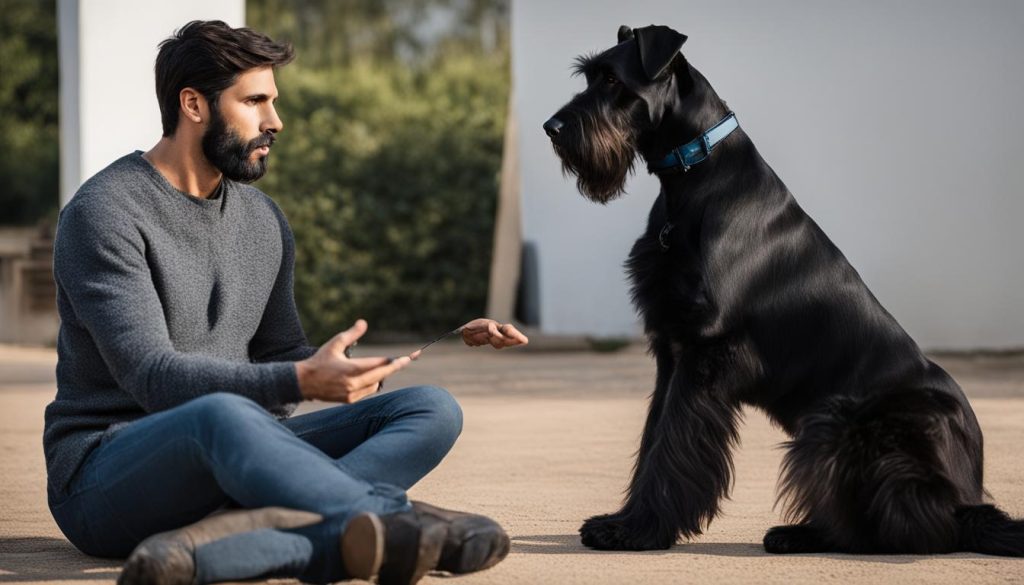
Advanced Training Techniques for Giant Schnauzers
Once you’ve mastered the basics of Giant Schnauzer training, it’s time to take their training to the next level. Advanced training techniques can further enhance their skills and abilities. Here are some key techniques to consider:
1. Leash Training
Leash training is crucial for ensuring that your Giant Schnauzer walks calmly on a leash without pulling. Start by introducing the leash gradually, allowing your dog to get comfortable wearing it. Then, use positive reinforcement to reward them for walking by your side and not pulling. With consistent training and patience, your Giant Schnauzer will become a well-behaved walker.
2. Command Training
Command training aims to expand your Giant Schnauzer’s repertoire of commands. Once they have mastered basic commands such as sit, stay, and come, you can introduce more advanced commands like heel, speak, and fetch. Use positive reinforcement and repetition to reinforce these commands, making sure to reward your dog for correct responses.
3. Advanced Obedience Training
Advanced obedience training challenges your Giant Schnauzer both mentally and physically. Incorporate activities that require problem-solving skills, such as puzzle toys or agility training. This helps keep their minds sharp and prevents boredom. Additionally, advanced obedience training builds their overall discipline and strengthens the bond between you and your dog.
Remember, advanced training requires patience, consistency, and positive reinforcement. It’s important to break down each new skill into smaller steps and gradually increase the difficulty as your Giant Schnauzer progresses.
Behavior Training for Giant Schnauzers
Giant Schnauzers are intelligent and loyal dogs, but like any breed, they can sometimes display behavioral issues such as aggression or separation anxiety. It is important to address these issues through behavior training to ensure that your Giant Schnauzer is well-adjusted and able to interact positively with people and other animals.
One effective technique for modifying unwanted behaviors is desensitization. This involves gradually exposing your dog to the trigger that elicits the undesired behavior, in a controlled and positive way. For example, if your Giant Schnauzer reacts aggressively towards other dogs, you can slowly introduce them to other dogs in controlled environments, ensuring positive experiences and rewarding calm behavior.
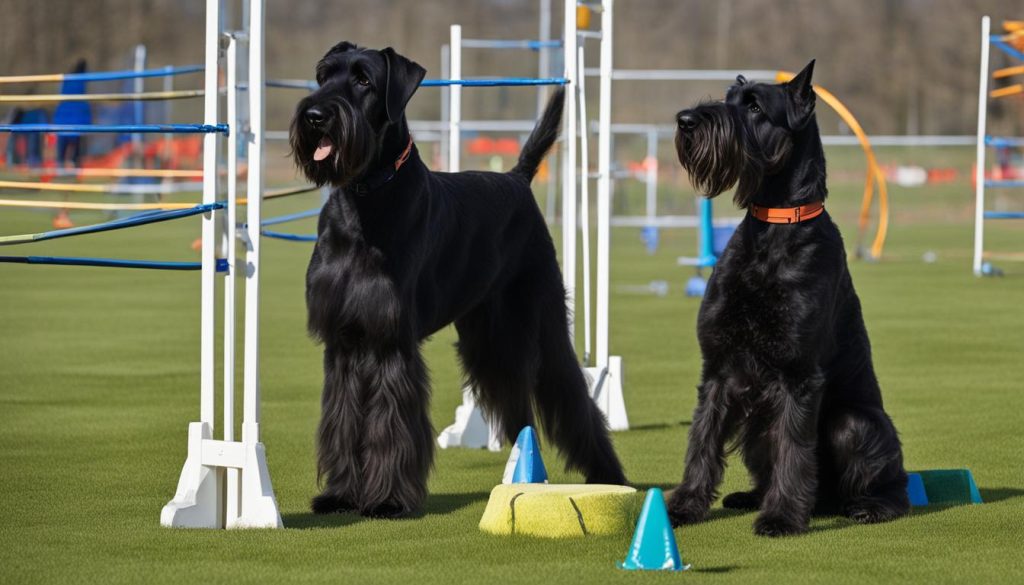
Counterconditioning is another valuable method for behavior training. It involves pairing the trigger of undesirable behavior with a positive experience. For instance, if your Giant Schnauzer becomes anxious when left alone, you can associate your departure with a special treat or toy. This can help create a positive association, reducing separation anxiety over time.
Consistency and patience are key when training your Giant Schnauzer’s behavior. It is important to provide clear boundaries and expectations, reinforcing positive behaviors with rewards such as treats, praise, or playtime. Additionally, seek guidance from a professional dog trainer experienced in behavior training if you are facing challenges beyond your expertise.
Tips for Successful Giant Schnauzer Training
Training your Giant Schnauzer requires professional techniques and effective strategies. By following these tips, you can ensure successful Giant Schnauzer training sessions and foster a well-behaved companion.
- Keep training sessions short and frequent: Giant Schnauzers have a high energy level, so it’s important to keep their attention focused during training. Short and frequent sessions, around 5-10 minutes each, are more effective than long and exhaustive sessions.
- Spread training throughout the day: Instead of having one long training session, break it down into several smaller sessions throughout the day. This helps prevent boredom and allows your Giant Schnauzer to absorb and retain the training material more effectively.
- Take advantage of mealtimes for training: Incorporate training exercises during mealtimes by using your dog’s regular meals as rewards. This reinforces positive behavior and creates a positive association with the training process.
- Use a variety of rewards other than food: While food treats are often used as rewards during training, it’s important to mix it up and use other rewards as well. This can include verbal praise, petting, playtime, or access to toys. Tailor the rewards to your Giant Schnauzer’s preferences to keep them motivated.
- Incorporate training into daily activities such as walks: Training should not be restricted to formal sessions only. Take advantage of daily activities such as walks to reinforce commands and behaviors. For example, practice walking on a loose leash or practicing commands like sit or stay during the walk.
Consistency is key in professional Giant Schnauzer training. It’s important to be patient and use positive reinforcement techniques throughout the training process. With dedication and the right approach, you can effectively train your Giant Schnauzer and enjoy a well-behaved and obedient companion.
Conclusion
Proper training is crucial for the well-being of your Giant Schnauzer. By understanding the breed, implementing basic and advanced training techniques, addressing behavioral issues, and incorporating training into daily life, you can ensure that your Giant Schnauzer becomes a well-behaved and obedient companion.
One of the key training tips for a well-behaved Giant Schnauzer is to be patient. These intelligent dogs respond well to positive reinforcement, so reward their good behavior consistently to encourage them to repeat it. Consistency is also important, as it helps establish clear boundaries and expectations.
Remember to incorporate training into your daily routine, using meal times as opportunities for reinforcement. Short and frequent training sessions throughout the day will help reinforce the lessons learned and prevent your Giant Schnauzer from becoming bored or overwhelmed.
With dedication and the right training techniques, you can master Giant Schnauzer training and enjoy a strong bond with your furry friend. Training is not only beneficial for your dog’s behavior, but also for their overall well-being and happiness. So, start implementing these training tips and enjoy the rewarding experience of having a well-behaved Giant Schnauzer by your side.
FAQ
What is the Giant Schnauzer breed known for?
The Giant Schnauzer is known for its intelligence and loyalty, as well as its bold and valiant nature.
How does the Giant Schnauzer compare to the Standard Schnauzer?
The Giant Schnauzer is a larger version of the Standard Schnauzer, with a more powerful and muscular build.
What training techniques should I use for my Giant Schnauzer?
Positive reinforcement training techniques are highly effective for Giant Schnauzers. These techniques focus on rewarding desired behaviors instead of punishing unwanted behaviors.
What are some basic training commands that I should teach my Giant Schnauzer?
Some basic training commands to teach your Giant Schnauzer include sit, stay, and come.
How can I housebreak my Giant Schnauzer?
Housebreaking your Giant Schnauzer involves establishing routines, providing regular potty breaks, and rewarding successful potty behavior.
Should I crate train my Giant Schnauzer?
Crate training can be beneficial for Giant Schnauzers as it provides them with a safe and comfortable space of their own.
What advanced training techniques should I use for my Giant Schnauzer?
Advanced training techniques for Giant Schnauzers may include leash training for proper walking behavior, command training to expand their repertoire of commands, and advanced obedience training to challenge their mental and physical abilities.
How can I address behavioral issues in my Giant Schnauzer?
Behavior training techniques such as desensitization and counterconditioning can be used to modify unwanted behaviors in Giant Schnauzers, including aggression and separation anxiety.
How can I make my training sessions with my Giant Schnauzer more effective?
To make your training sessions more effective, keep them short and frequent, take advantage of mealtimes for training opportunities, use a variety of rewards other than food, and incorporate training into daily activities such as walks.
Why is consistency important in Giant Schnauzer training?
Consistency is crucial in Giant Schnauzer training as it helps establish clear expectations and reinforces desired behaviors.
How long does it take to train a Giant Schnauzer?
The time it takes to train a Giant Schnauzer can vary depending on the individual dog and the complexity of the training goals. Patience, consistency, and positive reinforcement are key to successful training.

